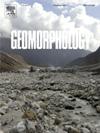Profile Integral: A robust and flexible metric to measure the concavity/convexity of a topographic profile
IF 3.1
2区 地球科学
Q2 GEOGRAPHY, PHYSICAL
引用次数: 0
Abstract
In geomorphology, topographic profile shapes are used to analyze landform characteristics, interpret erosional and depositional processes, and understand the evolution of landscapes over time. To more consistently measure the shape of topographic profiles in two dimensions (height vs. distance), we provide a new metric based on integrating the area under the profile. The metric is applicable to any cross-valley profile, slope profile, long profile, or arbitrary profile. By analogy with the Hypsometric Integral, we name this metric as Profile Integral (PI). It is a standardized value between 0 and 1, with 0.5 representing either a straight-line long profile or a V-shaped cross-profile, and values of >0.5 for convex profiles and < 0.5 for concave profiles. We develop a toolbox to assist in determining the PI and for comparison with other measures of profile shape, including the V-index, the VDWR, the k-curve, the power curve, and the quadratic polynomial. Our toolbox provides tools to delineate smoothed streamlines (thalwegs), generate a series of cross-profiles along streamlines, and derive the PI and a set of other metrics for both cross-valley and long profiles. We illustrate the toolbox with examples for an area in the Tian Shan, China, and another in Iceland, including situations where some cross profiles should be manually deleted. In both areas, PI provides a good measure of the degree of glacial modification of valleys, with expected down-valley variations. PI has strong correlations with most metrics that measure profile concavity based on a single parameter, while its correlations with metrics derived from those curve-fitting models that define profile shape with multiple parameters are relatively low. The advantages of the PI are (1) its low-skewed distribution and flexibility in providing a metric with similar interpretations for long profiles, slope profiles and valley cross-profiles and (2) its applicability to asymmetric cross-profiles in full, including those close to the confluence of tributary valleys (asymmetric cross-profiles, reaching different heights on each side, are common yet are excluded from most analyses of valleys and troughs). We, therefore, propose PI as the preferred and unified index for measuring the concavity/convexity of any topographic profile.

剖面积分:一种鲁棒和灵活的度量来测量地形剖面的凹凸度
在地貌学中,地形轮廓形状用于分析地貌特征,解释侵蚀和沉积过程,并了解景观随时间的演变。为了在两个维度(高度与距离)上更一致地测量地形轮廓的形状,我们提供了一种基于整合轮廓下面积的新度量。该度量适用于任何跨谷剖面、斜坡剖面、长剖面或任意剖面。与半对称积分类似,我们把这个度量称为轮廓积分(PI)。它是一个介于0和1之间的标准化值,其中0.5表示直线长轮廓或v形横轮廓,值为>;0.5表示凸轮廓和<;0.5为凹形型材。我们开发了一个工具箱来帮助确定PI,并与其他轮廓形状的测量进行比较,包括v指数、VDWR、k曲线、功率曲线和二次多项式。我们的工具箱提供了描绘平滑流线(thalwegs)的工具,沿着流线生成一系列交叉轮廓,并为交叉谷和长轮廓导出PI和一组其他指标。我们用中国天山的一个地区和冰岛的另一个地区的例子来说明这个工具箱,包括需要手动删除一些交叉剖面的情况。在这两个地区,PI可以很好地衡量冰川对山谷的改造程度,并具有预期的山谷向下变化。PI与大多数基于单一参数测量轮廓凹凸度的指标具有很强的相关性,而与那些基于多个参数定义轮廓形状的曲线拟合模型得出的指标的相关性相对较低。PI的优点是:(1)其低偏斜分布和灵活性,可以为长剖面、斜坡剖面和山谷交叉剖面提供类似解释的度量;(2)它完全适用于非对称交叉剖面,包括靠近支流山谷汇合处的非对称交叉剖面(每边达到不同高度的非对称交叉剖面很常见,但在大多数山谷和沟槽分析中被排除)。因此,我们建议PI作为衡量任何地形轮廓的凹凸度的首选和统一指标。
本文章由计算机程序翻译,如有差异,请以英文原文为准。
求助全文
约1分钟内获得全文
求助全文
来源期刊

Geomorphology
地学-地球科学综合
CiteScore
8.00
自引率
10.30%
发文量
309
审稿时长
3.4 months
期刊介绍:
Our journal''s scope includes geomorphic themes of: tectonics and regional structure; glacial processes and landforms; fluvial sequences, Quaternary environmental change and dating; fluvial processes and landforms; mass movement, slopes and periglacial processes; hillslopes and soil erosion; weathering, karst and soils; aeolian processes and landforms, coastal dunes and arid environments; coastal and marine processes, estuaries and lakes; modelling, theoretical and quantitative geomorphology; DEM, GIS and remote sensing methods and applications; hazards, applied and planetary geomorphology; and volcanics.
 求助内容:
求助内容: 应助结果提醒方式:
应助结果提醒方式:


